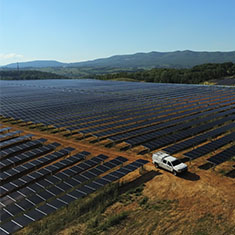
By Brian Garrett, principal and director of survey at Bowman
The solar industry is innovating and moving fast. It’s also young and still acquiring best practices. Today’s renewables developers sometimes rush through the crucial early surveying stage that developers in older industries, such as utilities and construction, have learned not to overlook. Getting the lay of the land sets the planning for all that comes next, including whether a project will proceed. If done properly and early, it can avoid broken schedules and budgets.
Here are a few nightmare scenarios:
– A rushed survey failed to gauge the elevation of the property by 6 ft, and now your site is underwater due to a flood.
– You expected an elevation of 100 ft, but it’s actually 101 ft. Sounds like a negligible difference, but it isn’t. This is what’s known as a “grade bust,” and it’s as bad as it sounds.
– You arrive at your site to find someone logging trees. But your indignation quickly turns to sheepishness when you learn that the person is actually on their own property. Your survey was off by dozens of acres.
– The site you thought was one size turns out to be three-times as large — and 800 ft in the wrong direction.
The dangers implied by these revelations are obvious: multimillion-dollar lawsuits, angry customers, missed deadlines, blown-up budgets and even neighboring property owners dictating terms that push your project into the red. It also hurts the industry’s reputation, especially if mistakes lead to negative headlines.
When the lack of survey work leads to unpleasant surprises, the costs can be as many as two to three times more expensive. This shouldn’t come as a surprise. If you build a deck on your house incorrectly, you have to tear it down and rebuild it. With commercial-level projects, there also will likely be an investigation involved, which adds yet more costs.
How does this happen?
Unfortunately, very easily. New technology has been the lifeblood of the industry. But it can also be a curse. We’re awash with new aerial photography, lidar and mapping tools. It can give the impression that all you have to do is put a drone in the air, click some buttons and create a surface that’s a faithful representation of the real thing. Equipment is available so anyone can operate and get a result. It doesn’t mean it’s the right result.
Geographic information systems (GIS) tools are widely misunderstood. GIS data, publicly and readily available, makes for an enticingly low-cost solution for a real-world development project. But GIS is absolutely not meant for this purpose. The giant disclaimers saying as much on these sites aren’t wrong. Buying lidar mapping data may seem like the more responsible path. But even there, the quality of the data may be low: it’s intended for general use, not for designing projects. Aerial data doesn’t take long to become outdated, as anyone familiar with Google Earth can tell you.
Veterans of other industries know the trick is to get in early and give surveying the time it needs to be done right. New technology is only as good as the initial survey control data you put into it. Use whatever it takes to achieve the precision you need — conventional survey technology, remote sensing, drones, aerial survey, 3D laser scanning or terrestrial surveys.
This includes getting in there personally with boots on the ground. Even with the best of tools, the data needs to be “ground-truthed,” or physically verified.
A robust QA/QC process prevents bad surprises later. Whatever data you start with, confirm it and confirm it again by getting out there and looking. If your surveyors aren’t doing that, they’re not doing it right.
“Doing it right” doesn’t mean following best practices for their own sake. It’s about not having the project blow up late in the game for easily avoided reasons. As the experienced like to say: There’s never enough money to do it right the first time. And yet there’s always money to do it right the third time.
This article first appeared in Solar Power World.



